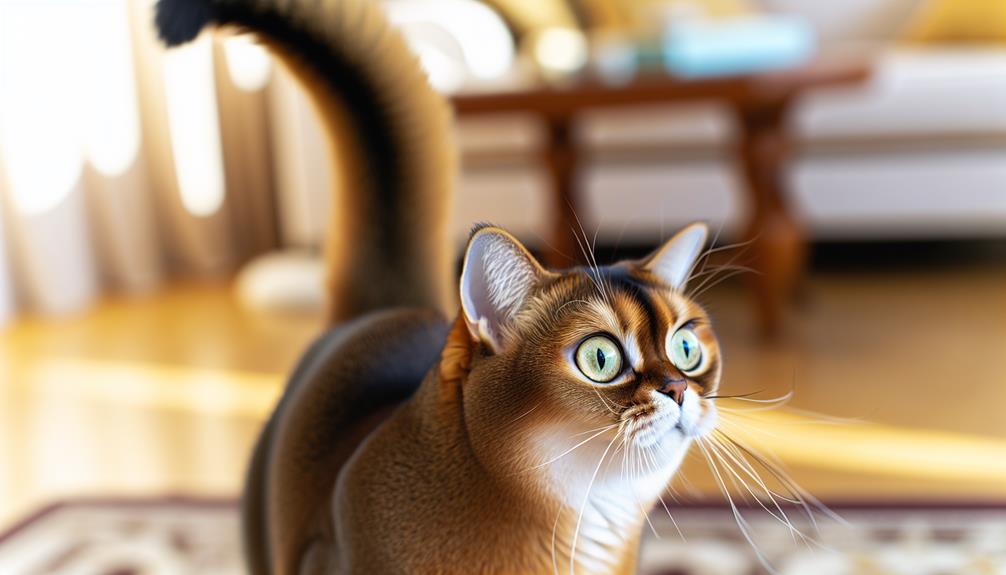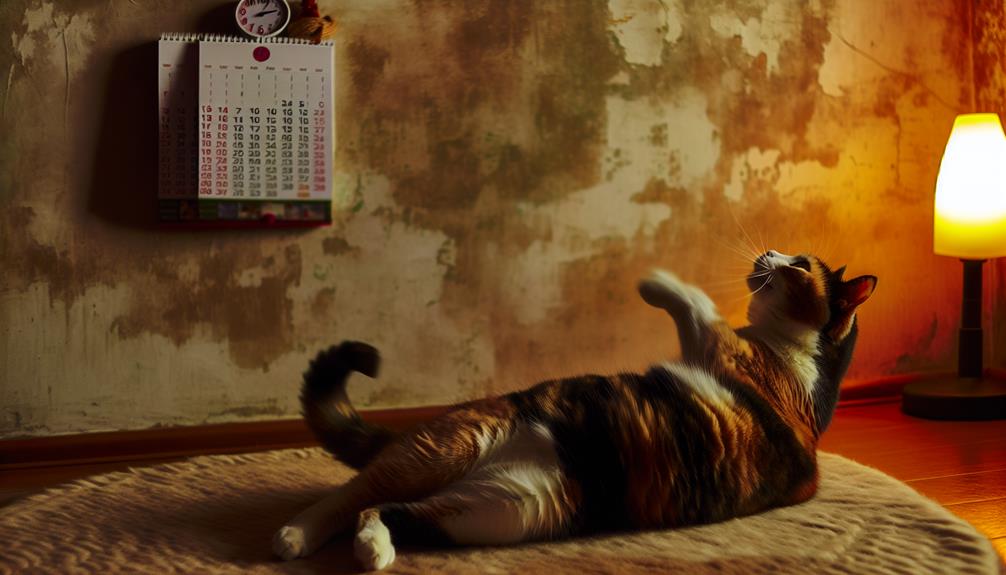Imagine a clock that ticks unpredictably, marking the rhythm of your cat's heat cycle. You probably know that cats can be in heat for about four to ten days, but did you know the frequency can vary with factors like age, breed, and even daylight? Understanding the intricacies of this natural process can help you manage those restless nights and the increased vocalization your feline friend exhibits. You might be wondering how to better cope with these cycles or if spaying could be a solution. Let's explore how you can make this time easier for both you and your cat.
Understanding the Heat Cycle
The feline estrous cycle, often referred to as the heat cycle, is a critical aspect of understanding your cat's reproductive health. This cycle is divided into several phases, each characterized by specific hormonal changes that influence your cat's behavior and physiology. Understanding these heat cycle phases can help you better manage your cat's health and well-being.
The heat cycle in cats typically consists of four phases: proestrus, estrus, metestrus (or diestrus), and anestrus. During proestrus, your cat may display increased affection and mild restlessness, but she won't yet be receptive to mating. This phase is marked by the initial hormonal changes, particularly the rise in estrogen levels.
Estrus, the second phase, is where your cat will exhibit more noticeable behavioral changes, such as loud vocalizations, increased affection, and a heightened desire to roam. This is when she is receptive to mating, driven by peak estrogen levels. If mating doesn't occur, the cycle progresses to the metestrus phase.
Metestrus, or diestrus, involves a decline in estrogen levels and the rise of progesterone if your cat has mated and ovulated. This phase is relatively short if fertilization hasn't occurred.
Duration of Estrus
During the estrus phase, which is typically the most conspicuous part of the heat cycle, cats experience a period of sexual receptivity that usually lasts between four to ten days. This duration can be influenced by various factors such as hormonal changes, environmental conditions, and the cat's age.
Understanding the estrus phase is essential for effective feline reproduction management. During this time, you'll notice estrus signs that indicate your cat is ready for mating. These signs are triggered by hormonal changes that prepare the cat's body for potential breeding. It's important to be aware of these changes to make informed breeding considerations.
Outdoor behaviors often become more pronounced during estrus as the cat seeks out male interactions. This can lead to increased risks such as traffic accidents or encounters with other animals, impacting the cat's health. Additionally, environmental factors like the length of daylight can also influence the duration and intensity of the heat cycle.
Here's a table summarizing key factors influencing the duration of estrus:
| Factor | Influence on Estrus Duration | Notes |
|---|---|---|
| Age Differences | Younger cats may have shorter cycles | Older cats may have longer cycles |
| Environmental Factors | Longer daylight can extend duration | Indoor cats may have varied cycles |
| Male Interactions | Presence of males can prolong estrus | Absence can shorten duration |
| Health Impacts | Illness can affect cycle length | Healthy cats have regular cycles |
| Breeding Considerations | Mating can shorten estrus period | Unmated cats may have longer cycles |
Behavioral Signs

During estrus, you'll notice your cat exhibiting increased vocalization frequency, often characterized by loud yowling. This vocalization is typically accompanied by restlessness and agitation, as she attempts to attract potential mates. These behaviors are stark indicators that your cat is in heat and are driven by hormonal changes.
Increased Vocalization Frequency
When a cat is in heat, one of the most noticeable behavioral signs is a marked increase in vocalization frequency. This heightened vocal activity serves as a primary means of cat communication, signaling her reproductive availability. Understanding the vocalization triggers can help you identify and manage these periods more effectively. The following are key characteristics of increased vocalization frequency in cats during heat:
- Loud and Prolonged Meowing: The cat's meows become louder and more persistent, resembling yowling or calling, which serves to attract male cats.
- Vocalization at Night: Cats in heat often vocalize more during the night, disrupting your household's sleep patterns.
- Frequency of Calls: You'll notice that the cat's vocalizations occur more frequently, often in response to specific environmental stimuli or changes, such as the presence of other cats or even changes in household activity.
- Variation in Vocal Tones: The cat might employ a range of tones and pitches, making her vocalizations more noticeable and distinct from her usual sounds.
These vocalization behaviors are hormonally driven and are a normal part of the feline estrous cycle. By recognizing these signs, you can better understand and anticipate your cat's needs during her heat cycle.
Restlessness and Agitation
Restlessness and agitation are hallmark behavioral signs indicating that a cat is in heat. When your cat exhibits these behaviors, it's often linked to the substantial hormonal changes occurring in her body. During estrus, the levels of estrogen surge, prompting a cascade of mating behaviors aimed at attracting a male.
You'll notice that she's more active and unable to settle in one place for long. This restlessness is a direct response to her heightened reproductive drive. Scratching at doors, pacing, and increased grooming are common manifestations. Clinically, this activity spike is a consequence of her biological imperative to seek a mate.
Agitation often accompanies restlessness. Your cat may appear irritable or overly affectionate, rubbing against furniture or even you more frequently. This agitation is a behavioral expression of the internal hormonal storm she's experiencing. The combination of these behaviors is a clear signal that she's in heat and ready to mate.
Understanding these signs can help you manage her condition more effectively. Whether you aim to breed her or prevent unwanted litters, recognizing restlessness and agitation as indicators of estrus is essential for timely intervention.
Frequency of Heat Cycles
You'll observe that the frequency of a cat's heat cycles can vary, typically occurring every 2 to 3 weeks during the breeding season. These cycles are influenced by seasonal patterns, with increased frequency in longer daylight periods. Understanding these variations is essential for managing reproductive health and preventing unwanted pregnancies.
Cycle Length Variations
Understanding cycle length variations in cats is vital for managing their reproductive health. A cat's heat cycle, or estrous cycle, can be influenced by several factors, each contributing to how frequently she enters heat. Here's a closer look:
- Age Factors: Younger cats, or queens, may experience more frequent heat cycles due to heightened hormonal changes compared to older felines. As your cat ages, these cycles may become irregular or less frequent.
- Breed Differences: Certain breeds, such as Siamese, are known to have shorter intervals between heat cycles, while others may have longer periods of anestrus (non-reproductive phase).
- Environmental Influences: Light exposure plays a significant role. Cats exposed to continuous light may have more frequent cycles. Conversely, those kept in low-light conditions might experience fewer cycles.
- Health Considerations: Underlying health conditions, stress effects, and overall nutrition impact can alter the frequency and regularity of a cat's heat cycle. Proper diet and stress management are vital to maintaining a balanced reproductive cycle.
Managing these factors effectively can help in predicting and controlling your cat's heat cycles, ensuring ideal reproductive health. Regular veterinary check-ups are recommended to address any health considerations promptly.
Seasonal Heat Patterns
In temperate climates, seasonal heat patterns greatly influence the frequency of a cat's heat cycles. Feline reproductive activity is typically linked to photoperiods—daylight duration. Longer daylight periods in spring and summer stimulate ovarian activity, leading to more frequent estrus cycles. Conversely, shorter days in autumn and winter generally result in fewer heat cycles or even anestrus, a period of sexual dormancy.
Environmental factors play a pivotal role in modulating these seasonal changes. Indoor cats exposed to artificial lighting may experience altered heat cycles compared to their outdoor counterparts. Artificial lighting can simulate longer daylight periods, potentially causing your cat to enter estrus more frequently, regardless of the actual season.
Evidence-based studies suggest that cats living closer to the equator, where daylight hours are relatively consistent year-round, may experience less pronounced seasonal variations in their heat cycles. This illustrates the significant impact that environmental factors, such as light exposure, have on feline reproductive physiology.
Understanding these seasonal heat patterns can help you manage your cat's reproductive health more effectively. If you're dealing with a cat that has irregular cycles, consider environmental adjustments or consult a veterinarian for tailored advice. This expert knowledge can aid in predicting and mitigating heat-related behaviors.
Managing Your Cat's Heat

Dealing with a cat in heat can be challenging, but employing effective strategies can make the process manageable. Feline heat cycles, or estrus, can cause behavioral and physiological changes that demand careful heat management to guarantee your cat's comfort. Here's how you can manage these phases effectively:
- Environmental Enrichment: Provide plenty of toys and activities to distract your cat. Interactive toys and puzzle feeders can keep her mind engaged and reduce stress.
- Comfortable Environment: Create a calm, quiet space where she can retreat. Soft bedding and dim lighting can help in minimizing overstimulation, contributing to feline comfort during estrus.
- Increased Affection: Some cats benefit from extra petting and attention. Gentle stroking can soothe her and fulfill her increased need for affection, aiding in heat management.
- Herbal Remedies: Consider herbal supplements known for their calming effects. Products like catnip or valerian root, administered appropriately, can help in reducing anxiety and restlessness.
Managing a cat's heat effectively involves addressing both behavioral and environmental factors. Feline estrus is marked by increased vocalization, restlessness, and a strong drive to escape and find a mate. By enriching the environment and guaranteeing comfort, you can mitigate some of these signs. Additionally, while increased affection can provide emotional relief, herbal remedies offer a natural way to soothe your cat without resorting to pharmaceuticals.
Spaying and Its Benefits
Spaying offers a multitude of benefits for both your cat and you as an owner. One of the primary spaying benefits is the reduction of undesirable behaviors associated with the estrous cycle. Cats in heat often exhibit loud vocalizations, frequent urination, and restlessness, behaviors that can be considerably minimized or eliminated through spaying.
From a clinical standpoint, spaying provides substantial health advantages. The procedure dramatically decreases the risk of uterine infections (pyometra) and mammary gland tumors, which are malignant in approximately 90% of cats. Pyometra, a life-threatening condition, requires emergency medical intervention, often more complex than a routine spay.
Furthermore, spaying before the first heat cycle offers the most considerable health benefits. Studies show that early spaying (before six months of age) can nearly eliminate the risk of developing mammary cancer. The procedure also prevents ovarian and uterine cancers entirely, as these organs are removed during surgery.
Behavioral improvements are another vital aspect. Spayed cats are less likely to engage in territory-marking behaviors, such as spraying urine, and are generally calmer. This can enhance the human-animal bond, making your home environment more harmonious.
Economically, the cost of spaying is far less than the cumulative expenses of managing heat cycles, potential pregnancies, or treating reproductive-related health issues.
Conclusion
So, now you know the ins and outs of your cat's heat cycle. Can you imagine a more effective way to manage this than spaying? Not only will it alleviate the discomfort and behavioral changes your cat experiences, but it also offers long-term health benefits. By opting for spaying, you're ensuring a more stable and content life for your furry friend, free from the frequent and often distressing cycles of estrus.
